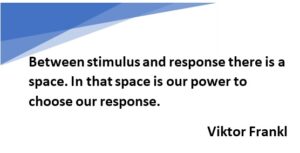This week, I invite you to walk through an exercise in Leading by Two.
1. Recognize your partners: With whom are you Leading by Two? My partners and I have become quite clear that “Leading by Two” (LX2) describes not only a what – a relationship with a single essential partner – but it illuminates a how. The proven principles we use to build and strengthen our LeadingX2 executive clients also apply to the many other paired relationships in their personal and professional lives. You likely have many such dyads in your own life.
Consider your important dyadic relationships. Who first came to mind? Spouse? Co-worker? Manager? Child? Client? Imagine any one of them walks into the room you’re in, and asks, “Can I talk to you about something?” Step 2:
2. Notice your reactions: Presumably, you’d answer, “Sure come in, sit down.” But before you imagine how you would answer the question, stop and go inside yourself . . . to the place(s) where feeling precedes and/or is interwoven with thoughts. See if you can locate feelings. The best way to do this is go slow and avoid mentally grabbing the culturally “correct answer,” the acceptable, if not cool or impressive description of how you feel when so approached. The cool answer would belong on a happy spectrum: e.g., excited, open, honored, grateful, curious. Maybe those descriptions are accurate, but observe yourself as if you don’t know yourself. Just notice without changing, correcting, or tweaking your feelings. And, by the way, you almost certainly have mixed feelings.
What did you observe?
Personally, when I remember or imagine being asked, “Can I have a minute?” the feelings are similar, whether I’m considering my spouse, partners, adult kids, clients, co-faculty members, or dean of instruction. Candidly, my primary feeling – in the senses of both first and strongest – is located on the fear spectrum. Not outright terror. Maybe trepidation. Or just anxiousness. A stronger fear with some people than others. My emotional-body’s response in the hyper-instant when I hear, “Can I talk to you?” is to prepare, to guard, to tense a little and to ready my defenses. Without “thinking,” I examine the recent past for clues: “What did I do? Am I late? Did I forget something? Did I say something stupid, sexist, racist? Is this going to take a lot of time (that I already fear I don’t have)?” I even may wonder if I’m in for a big shock: “Are they taking a class away from me? Is my client taking their business elsewhere? Is someone in the family sick…dead?”
As always, I have mixed feelings! I likely feel something in the love family: I hope I can help and/or hope it may be a good conversation. I might feel a little on the anger spectrum, like mild frustration (“what did I do this time?”) or irritation. What do you notice?
3. Grow in self-awareness: In great partnerships, when we are Leading by Two, the partnership grows when we openly listen to our partner. In our research, the most oft-mentioned factor for success in partnership is “open communication.” If you slowed down in this little exercise and noticed feelings like I did, and if the request to talk triggered perfectly human and largely unconscious, suppressed and defensive feelings, then YAY! Yay, because when you are not aware of such feelings, you will naturally close off from communication. But when you become aware of your feelings and the resulting defensive mindset, you create the choice to OPEN! You can choose to trust your ability to navigate whatever information, request, or hurt feelings your partner may open up to you about. By trusting that you can hear whatever they need to say, you open the bandwidth of communication! 
Next week, I’ll take some of these reflections on how our natural, early warning systems of defense not only impact our listening but can make us tremendously more effective in speaking so our partners can hear us. Look for some super practical tips for speaking so you can be heard and…
Lead with your best self.

Thinking of partners, first to mind are people like Warren Buffet and Charlie Munger, and Barack and Michelle Obama, or Oscar and Hammerstein, or the George and Ira Gershwin, or Mother Theresa and God. We cannot think of either of the partners without the other. Being open to any kind of discussion is of great value. The bond is a set of commonalities, beliefs, goals, knowing the value of the partnership, and so many other things, but in the end all of these amount to respect and love.